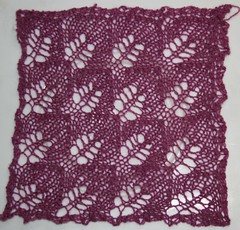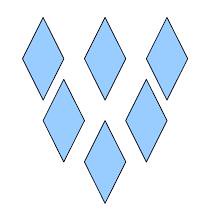Both Gail and Luiza use the exact same construction and it's no coincidence. Knitting a shawl from the neck down is a great way to use the most of the yarn you have without running out of yarn or leaving out parts of designing elements.
The fact that I used leaves isn't an accident either. Granted, I do like leaf pattern sts, but it's the shape that makes leaves so easy to place on a triangular shawl.
Because leaves usually have increases on both sides, it makes for a smooth riding when placing them in a triangular shape without having to do pieces of a st pattern - the increases are there for the designer already, no need for complex calculations!
Now, before I get designers angry at me thinking I'm dismissing their efforts, let me say this. What I wrote above is a gross simplification of the process so people can understand the construction of a shawl. People thinking that all they have to do is crack open a stitch dictionary, choose a st pattern and publish a "new design" are bound to be disappointed with the number of items knit from it.
A good design involves putting together different elements in a harmonious way, and most times, to achieve that, a designer has to modify (heavily) a st pattern or create their own.
Back to the topic. Some time ago Fleegle described Luiza as being a beer bottle shawl - as in the song 99 bottles of beer on the wall. I had the image in my mind for some time already, but had never thought about the song. And it makes perfect sense.
Imagine, if you will, a pyramid made of cans. How would you go about stacking the cans up? Every row has one less can than the previous one, right?
Now, if you turn the pyramid upside down, you’ll have a clear image of how each half (left and right) of the shawl is created. So:
- on the first row you have one can,
- on the second you have two,
- on the third you have three…
Each row of cans is actually a repeat. Did you notice that the row number is the same as the number of repeats you have on that row?

I blame the smooth time I have putting st patterns together on 2 years of folding origami tessellations. When doing them there are only so many geometric shapes that will behave well (give you a decent grid): triangles and squares being the best two.
Paper, of course, is way less flexible than yarn, and there are only so many shapes you can create when following the grid lines, yet the combinations are mind blowing.
Somehow, this mental exercise made it easier for me to visualize how different st patterns go together and I usually only tink because I find out I'm running out of yarn or I decided that an element doesn't go so well where I'd put it.
If you look closely at a leaf, you'll realise it's a rhombus, or two triangles placed together with one side touching. The rhomboid shape makes them very easy to stack together.

I hope I didn't make things ever harder to understand. Feel free to message cursing me for my lacking of writing skills.
Thanks for sharing this! It's always interesting to me to see the geometry behind knitting designs!
ReplyDeleteYou are awesome, Jane! Also, I should really be following your blog . . .
ReplyDeletejane,
ReplyDeletei love your work. i am knitting nightsongs now, but i am haveing a problem. after the first 33 rows you said repeat starting with row 3. won't this double the shawl in one row. and it doesn't seem to fit the pattern right. is this right or am i doing something wrong. please help me. i can't wait to wear this beauty.
thank you so much.
Rebecca
rjs30@gtownonline.com
Rebeca,
ReplyDeleteplease read this post:
http://coloursfromchaos.blogspot.com/2010/07/little-note-on-gail-aka-nightsongs.html